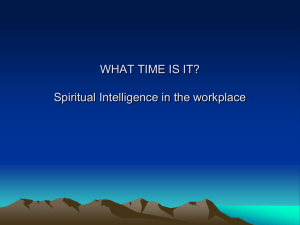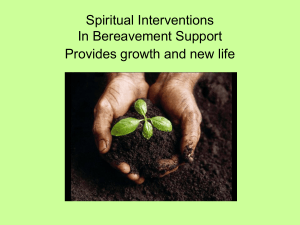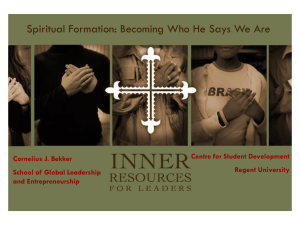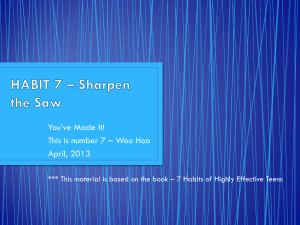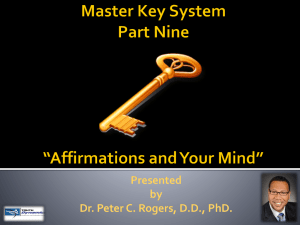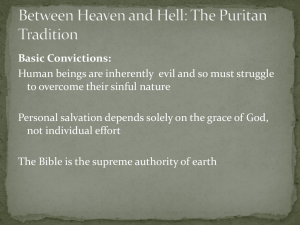Powerpoint
advertisement
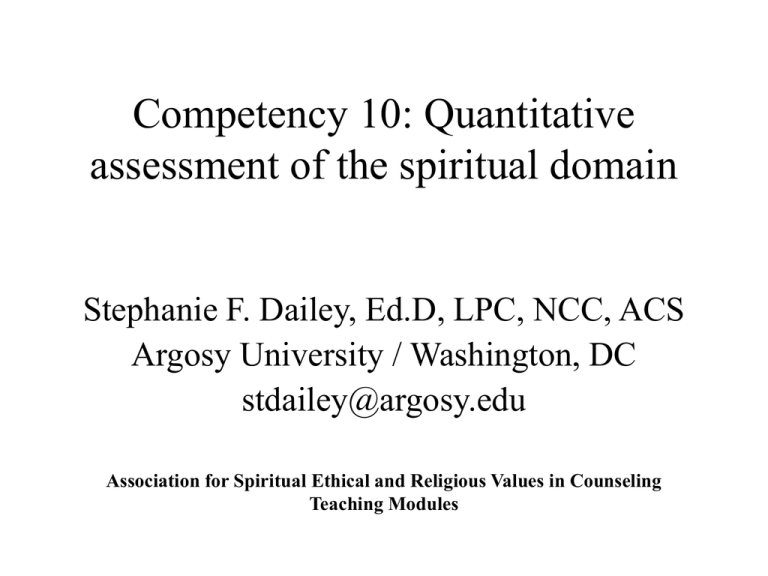
Competency 10: Quantitative assessment of the spiritual domain Stephanie F. Dailey, Ed.D, LPC, NCC, ACS Argosy University / Washington, DC stdailey@argosy.edu Association for Spiritual Ethical and Religious Values in Counseling Teaching Modules Module Outline Historical Perspective of Spiritual / Religious Integration Spiritual Competency Introduction to Spiritual Assessment Methods of Assessment Models of Spirituality and Related Formal Assessments Wellness Models and Related Assessments Case Example: James Measuring Competence: A Formal Assessment Tool for Educators Historical Perspective Traditionally religious beliefs were equated with pathology and left out of the therapeutic setting. - Favier, O’Brien, & Ingersoll, 2000; Young, Wiggins-Frame, Cashwell, 2007 Clients have feared that their beliefs would be misunderstood and undermined; and professionals have been unsure how to address these issues in counseling. - Anandarajah & Hight, 2001; Souza, 2002 Gradually, professionals have acknowledged that spiritual / religious beliefs are essential to the counseling process. - Burke et al., 1999; Cashwell & Young, 2004; Kielty-Briggs & Dixon-Rayle, 2002 ASERVIC identified Competencies for addressing Spiritual and Religious Issues in Counseling which included spiritual assessment as a requirement for the appropriate and ethical integration of religion and spirituality into the counseling process. - Miller & Thoresen, 1999; ASERVIC, 2009 Timeline 1951: The Catholic Guidance Council was formed and became the National Conference of Guidance Councils in 1958 1955: Catholic Counselors in APGA was created and met until 1973 1977: These two joined and renamed themselves ARVIC 1993: Inclusion of “Spirituality” (ASERVIC) 1994: First ASERVIC Summit on Spirituality 1994: DSM introduced “Religious or Spiritual Problems” as a V-Code. 1999: Spiritual Competencies Developed 2001: CACREP Standards included spiritual and religious beliefs as one aspect of a person’s culture 2003: AMCD endorsed culturally appropriate interventions, strategies, and techniques that include religious and spiritual beliefs 2005: Religion / spirituality incorporated into the ACA Code of Ethics (2005, C.5) 2009: CACREP Standards mandated the need to address spirituality in core curriculum 2009: Revised ASERVIC Spiritual Competencies Spiritual Competency Competence in counseling is collectively defined by a series of standards and guidelines. Spiritual competence is defined by the revised Competencies for addressing Spiritual and Religious Issues in Counseling. Six Factors: Culture and Worldview, Counselor Self-Awareness, Human and Spiritual Development, Communication, Assessment, and Diagnosis and Treatment. Assessment: Competency 10: During the intake and assessment processes, the professional counselor strives to understand a client’s spiritual and/or religious perspective by gathering information from the client and/or other sources. - ASERVIC, 2009 Introduction to Spiritual Assessment Assessment defined: “the act of determining the amount of value or importance an individual assigns to a specific construct, such as spirituality” - Harper & Gill, 2005, p. 32 Rational for assessment Gains of assessment – Context and worldview – Spiritual and/or religious issues – Strengths and resources – Interventions – Diagnosis – Self-exploration (counselor and client) Methods of Assessment • Assessment begins as soon as the client enters the counseling setting - Frame, 2003; Gill, Harper, & Dailey, 2011 • Quantitative (formal) & Qualitative (informal) assessment strategies Q u an titative P ros Q u alitative P ros • • • • • • • • Q uantifiable res ults C omparab le re s ults P reset co vera ge of the mes T ime e ffic ie nt F lexib le ter m ino lgy F lexib le exp lora tio n F ocus on s trengths Assessme nt ca n be a n inte rve ntio n Q u an titative C on s Q u alitative C on s • • • • • • • F ocus lim ited by ins tr um ent P redete r mined te rm ino lo gy S earch fo r de fic its F ocus lim ited by assess or a nd c lient N ot q ua nitfiable Lim ited co mpa rability T ime inte ns ive - Harper & Gill, 2005, p. 40 Models of Spirituality and Related Formal Assessments Spiritual Well-being Model: Ellison (1983) A continuous, dynamic reflection of one’s spiritual health and maturity. Indicated by a set of beliefs / values. - Paloutizan & Ellison, 1982 Spirituality is comprised of both religious and spiritual domains, each distinct. Spiritual Well-being Scale (SWBS; Ellison, 1983) Assesses religious and existential well-being (belief systems). Consists of 20 items with a 6-point Likert-type scale. Helpful when the client is struggling in the area of spiritual beliefs and if the counselor has difficulty recognizing the client’s belief system. - Harper & Gill, 2005 Models of Spirituality and Related Formal Assessments Westgate’s Model of Spirituality (1996): Based on four dimensions: unifying interconnectedness, purpose and meaning in life, and innerness, and transcendence. Westgate applied these principles to holistically conceptualizing and treating depression. Howden Spirituality and Assessment Scale (SAS; 1992) Assesses spiritual wellness factors consistent with Westgate’s model. - Harper & Gill, 2005 Consists of 28 questions with a six-point Likert-type scale. Subscales can be scored and used individually and collectively. Contains universal language and the model and theory are empirically validated by factor analysis. - Stanard, Sandhu, & Painter, 2000 Models of Spirituality and Related Formal Assessments Daily Spiritual Experiences (DSE; Underwood & Teresi, 2002) Examine individuals’ perceptions of, and interactions with, the divine in daily life in relation to potential health benefits. Underwood & Teresi observed that DSE enrich and contribute to: – supportive relationships, which corresponds to better health; – buffer stress, anxiety, depression, and the use of alcohol in relation to coping with stress; – correspond to an improved quality of life; and – may be utilized to enhance resilience and cope with illness. Daily Spiritual Experiences Scale (DSES; 2002) 16-items which address spiritual and religious experiences and perceived closeness to God. Demonstrated positive psychometric properties to measure DSE. - Stanard, Sandhu, & Painter, 2000 Formal Assessment Tools Brown-Peterson Recovery Index (B-PRPI; Brown & Peterson, 1991) 53-item inventory developed specifically for measuring spirituality in members of Alcoholics Anonymous (AA). Has also been used to assess progress in recovery programs. Spiritual Health Inventory (SHI; Veach & Chappel, 1992) 18-item self-report instrument with four scales: personal spiritual experience, spiritual well-being, sense of harmony, and personal helplessness. Spirituality Scale (SS; Jagers & Smith, 1996) 20-item measure assesses spirituality from an Afrocultural viewpoint. Based on spirituality as a worldview or organizing principle in African culture. Goes beyond church affiliation and includes physical death and continuity with ancestors. Formal Assessment Tools Spiritual Assessment Inventory (SAI; Hall & Edwards, 1996) 43-item inventory which measures both the spiritual and psychological aspects of spiritual maturity defined in a JudeoChristian context. Religious Coping Scale (RCOPE; Pargament, Koenig, & Perez, 2000) 105 item scale which asks respondents to rate various types of religious coping used when dealing with a negative life events. Based on a Judeo-Christian perspective – designed specifically to measure the client’s religious system. Jewish Religious Coping Scale (Rosmarin, Pargament, Krumrei, & Flannelly, 2009) and the Hindu Religious Coping Scale (Tarakeshwar, Pargament, & Mahoney, 2003) are available. Wellness Models and Related Assessments The Indivisible Self (Sweeney & Witmer, 1991): Proposed a model of wellness, The Wheel of Wellness, for counselors based on Adler’s five life tasks. Places spirituality at the core of well-being. Factor analysis modified the original model and resulted in The Indivisible Self (Sweeney & Myers, 2005). Five Factor Wellness Inventory of Lifestyle (5F-Wel) Designed to assist individuals in making healthier lifestyle choices based on the Indivisible Self model. Primarily used as a screening instrument to assess where wellness interventions need to be targeted. Cultural adaptations and age specific versions of the 5F-Wel are available. - Myers & Sweeney, 2008 Case Example: James James is a 52-year-old married Caucasian male with no significant health problems. He has one child who just dropped out of college. James lost his job two years ago and financially his family is stable because of his wife’s job. However, they have had to cut back which includes dropping financial assistance to their son. In his marriage he is “removed”. James identifies as Baptist. James states he does not want to be around people – even family. For the past few months he has little by little pulled back from his church which is really regrets. His wife is complaining that he is a “wet blanket” as he does not joke around like he used to. He reports he simply does not have the energy he once had. He says he spends most of his time now watching TV. He uses the words useless and a disappointment. He says that he has no energy to look through the want ads and feels like he just cannot take another interview and the subsequent disappointment. He states that everyone would be better off if he was gone, but he knows killing himself is a sin so he does not do it. He also notes , “Not that it matters, God has left me”. - Adapted from Harper & Gill, 2005, pp. 54-55 Measuring Competence: A Formal Assessment Tool for Educators Spiritual Competency Scale (SCS; Robertson, 2010) Provided a foundation for ASERVIC’s revised Spiritual Competencies. Assesses counselor competency to address spiritual and/or religious issues in counseling. Can also be used as a measure of training outcomes. Consists of 90 items with a 6-point Likert-type scale ranging from strongly disagree to strongly agree. Can indicate levels of competence for counselors (comparatively).
